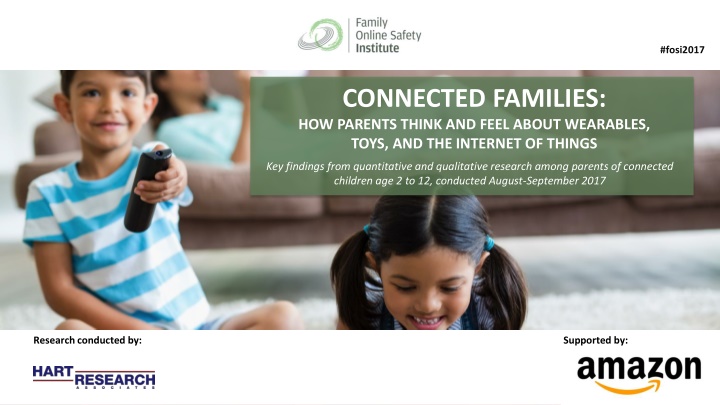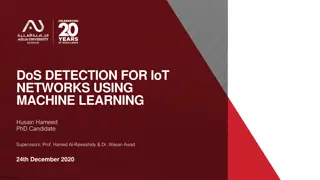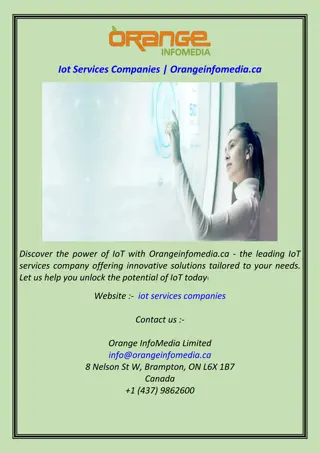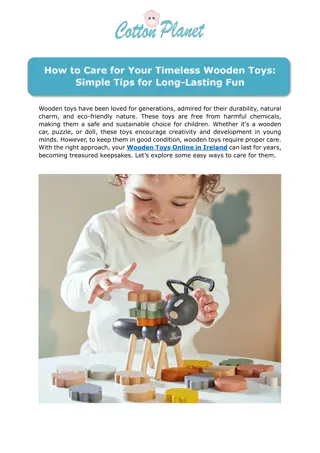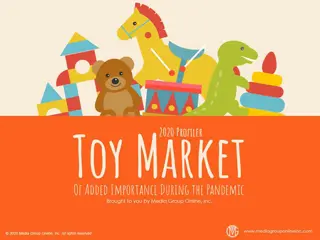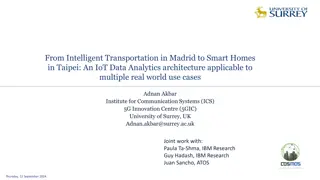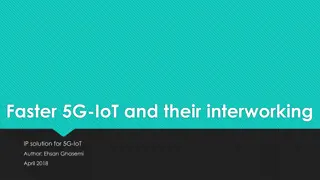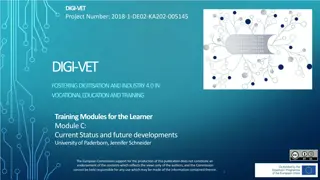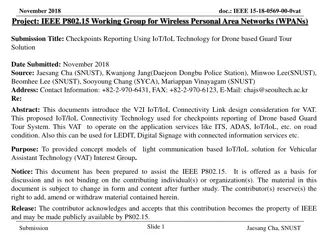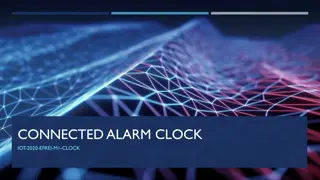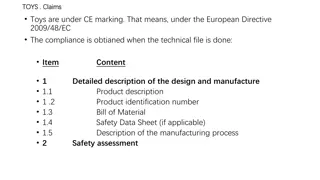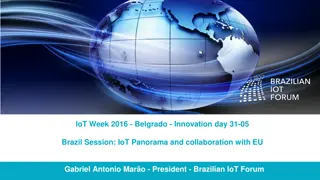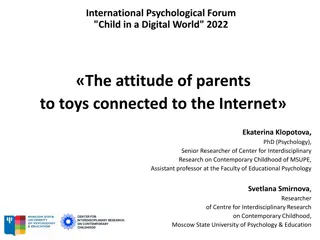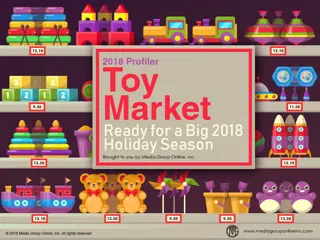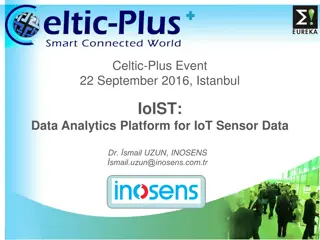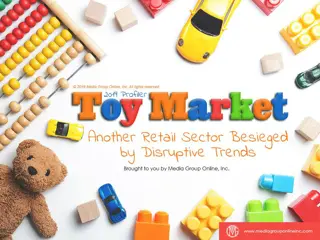Parents' Views on Wearables, Toys, and IoT Among Connected Children
This research delves into how parents of connected children aged 2 to 12 perceive wearables, toys, and the Internet of Things, with key findings from both quantitative and qualitative studies conducted in 2017. The study examines parents' attitudes, concerns, and expectations regarding their children's use of technology devices and connected toys. Insights are drawn from focus groups, surveys, and discussions among parents in different age segments.
Uploaded on Mar 02, 2025 | 3 Views
Download Presentation

Please find below an Image/Link to download the presentation.
The content on the website is provided AS IS for your information and personal use only. It may not be sold, licensed, or shared on other websites without obtaining consent from the author.If you encounter any issues during the download, it is possible that the publisher has removed the file from their server.
You are allowed to download the files provided on this website for personal or commercial use, subject to the condition that they are used lawfully. All files are the property of their respective owners.
The content on the website is provided AS IS for your information and personal use only. It may not be sold, licensed, or shared on other websites without obtaining consent from the author.
E N D
Presentation Transcript
#fosi2017 CONNECTED FAMILIES: HOW PARENTS THINK AND FEEL ABOUT WEARABLES, TOYS, AND THE INTERNET OF THINGS Key findings from quantitative and qualitative research among parents of connected children age 2 to 12, conducted August-September 2017 Research conducted by: Supported by: #fosi17
1 Methodology Three focus groups conducted in August 2017 Two in-person groups among parents of connected children* in Bala Cynwyd, Pennsylvania (suburb of Philadelphia), segmented by age of child: age 2 to 7, age 8 to 12 One online focus group among parents of children age 2 to 12 who have a connected toy Online nationwide survey among 601 parents of connected children* age 2 to 12, conducted September 21 to 29, 2017 * Connected children use the Internet and have access to technology devices. # fosi2017 Connected Families: How Parents Think And Feel About Wearables, Toys, And The Internet Of Things | September 2017 | Hart Research
These are parents of connected children age 12 and younger who are connected in many ways. 2 My child has this My child has access to this Tablet computer/iPad* 89% 22% 67% 89% Cell phone, smartphone* 53% 36% Desktop or laptop computer* 57% 29% 86% Video game console* 83% 33% 50% Handheld device or iPod w/Wi-fi capability* 60% 28% 32% Connected toy Wearable connected device (smart watch, fitness tracker 35% 4% 31% *Parents qualify for the survey if their child has one of these items or has access to one in the household. 31% 21% 10% # fosi2017 Connected Families: How Parents Think And Feel About Wearables, Toys, And The Internet Of Things | September 2017 | Hart Research
Children who do not already have these devices may have to wait a while to get them. 3 Mean age expect child will get each 9.3 Proportion saying child has 31% Mean age child got each 5.5 35% don t expect child will get this His/her own connected toy His/her own tablet computer or iPad 5.5 11.8 67% His/her own video game console His/her own wearable connected device (smart watch/fitness tracker) His/her own desktop or laptop 5.9 10.5 50% 24% don t expect child will get this 6.7 12.5 10% 7.1 12.7 29% His/her own e-mail account 7.4 13.2 38% His/her own smartphone His/her own social media account (Instagram, Snapchat, Facebook, Twitter) 7.6 12.9 34% 8.2 14.1 28% # fosi2017 Connected Families: How Parents Think And Feel About Wearables, Toys, And The Internet Of Things | September 2017 | Hart Research
Many parents are not familiar with the Internet of Things (IoT), but they respond favorably when read a description. 4 Feelings toward Internet of Things * Description of Internet of Things: The Internet of Things is the connection through the Internet of items that send and receive data. A thing, in the Internet of Things, is a connected device or smart device that collects data with the help of various technologies, including sensors, microphones, cameras, software, or other technologies. The Internet of Things allows these things to be sensed or controlled remotely through the Internet and enables them to share data and information that they collect. Very favorable Neutral Not familiar with Somewhat favorable Unfavorable 61% Some examples of things that are part of the Internet of Things are: Smart home appliances, such as smart thermostats, home security systems, and robotic vacuums A voice-controlled, Internet-connected speaker or smart speaker-- examples include Google Home and Amazon Echo or Echo Dot (which uses Alexa voice assistant) Remote health monitoring devices, such as those to monitor heart rate, blood pressure, and glucose levels Baby monitors with remote viewing and motion detection Wearable connected devices, such as smart watches, fitness trackers, and smart glasses Connected toys Self-driving cars 47% 35% 33% 24% 20% 15% 15% 26% 5% 13% Post-description* feelings Initial feelings # fosi2017 Connected Families: How Parents Think And Feel About Wearables, Toys, And The Internet Of Things | September 2017 | Hart Research
Majority of parents think IoT currently affects their familys daily life, and even more expect it to impact their family in 10 years. 5 Perceived/Expected Effect of IoT on Family s Daily Life A great deal Not at all A fair amount Only a little Just some 79% +21 points 58% 34% 36% 20% 22% 45% 12% 9% 13% 22% 6% 7% 3% Effect on daily life in 10 years Effect on current daily life # fosi2017 Connected Families: How Parents Think And Feel About Wearables, Toys, And The Internet Of Things | September 2017 | Hart Research
Smart TVs and speakers are pretty heavily used by children in households that have them. 6 My child uses this often My child uses this sometimes My child uses this but rarely does so Base: proportions who have each Internet-connected or smart TV 96% 30% 9% 57% 67% Voice-controlled, Internet-connected speaker/smart speaker (Google Home and Amazon Echo or Echo Dot with Alexa) 94% 23% 40% 12% 42% Internet-enabled thermostat, can control remotely w/smartphone 20% 67% 17% 23% 27% Internet-enabled home security system, can control remotely w/smartphone 25% 64% 17% 20% 27% # fosi2017 Connected Families: How Parents Think And Feel About Wearables, Toys, And The Internet Of Things | September 2017 | Hart Research
Parents weigh the benefits and harms of various technologies differently. 7 Benefits and harms about equal Harms of this outweigh benefits for my child Benefits of this outweigh harms for my child In general: Child using technology in general, including electronic devices/being online +32 46% 11% 43% Child having cell phone that is NOT a smartphone +42 Specific technologies: 28% 15% 57% Child having a connected toy 36% 19% 45% +26 Child having smartphone he/she can use to check e-mail, go online, download apps 31% 31% 38% +7 Child using voice-controlled, Internet-connected/smart speaker to search/shop online, etc. 34% 29% 37% +8 Child having a social media account (Instagram, Snapchat, Facebook, Twitter) +33 23% 55% 22% # fosi2017 Connected Families: How Parents Think And Feel About Wearables, Toys, And The Internet Of Things | September 2017 | Hart Research
Two in three parents of connected children under age 13 feel highly confident in managing their kids technology use. 8 Parents Confidence in Ability to Keep Track Of/Manage Child s Use of Technology Very confident 35% 30% 27% 35% 25% 36% 24% 29% 29% 33% 32% 42% 30% 20% 23% 29% 40% Very/fairly confident 74% 62% 64% 63% 69% 69% 64% 63% 64% 68% 67% 67% 66% 65% 61% 66% 71% Child age 2 to 4 Child age 5 to 8 Child age 9 to 12 Mothers Fathers Parents age 18 to 34 Parents age 35 to 44 Parents age 45/older White parents Non-white parents Hispanic parents High school grad/less ed. Some college College grad/more ed. Parents who use tech 3 hrs/less daily Parents who use tech 4-7 hrs daily Parents who use tech 8 hrs/more daily Not confident (0-5*) Very confident (10*) 13% Less confident (6-7*) 66% 30% very/fairly confident 21% Fairly confident (8-9*) 36% *Ratings on a zero-to-ten scale, 10 = very confident # fosi2017 Connected Families: How Parents Think And Feel About Wearables, Toys, And The Internet Of Things | September 2017 | Hart Research
A strong correlation emerges between the number of devices a child owns and a parent s confidence in managing use. 9 Confidence in Ability to Keep Track of/Manage Child s Use of Technology Very confident (10*) Fairly confident (8-9*) 72% 64% 51% 36% 37% 30% 36% 27% 21% Parents of child who owns no devices (14%) Parents of child who owns 1-2 devices (41%) Parents of child who owns 3/more devices (45%) # fosi2017 Connected Families: How Parents Think And Feel About Wearables, Toys, And The Internet Of Things | September 2017 | Hart Research
Parents who have a smart speaker are comfortable with their child using it; much lower comfort among parents who do not have them. 10 Comfort with Child Using Voice-Controlled, Internet-Connected/Smart Speakers Very comfortable Very uncomfortable Somewhat comfortable Somewhat uncomfortable 94% Comfortable with child using smart speaker, among parents of child who does not use Child age 2 to 4 Child age 5 to 8 Child age 9 to 12 Mothers Fathers Parents age 18 to 34 Parents age 35 to 44 Parents age 45/older Parents use of tech: Three hrs/less daily Four-seven hrs daily Eight hrs/more daily 52% 54% 63% 51% 64% 51% 61% 58% 35% 65% 57% 43% 39% 35% 40% 59% 29% 24% 26% 50% 56% 67% 6% 17% 14% 11% Parents of child who uses smart speaker All parents Parents of child who does not use smart speaker # fosi2017 Connected Families: How Parents Think And Feel About Wearables, Toys, And The Internet Of Things | September 2017 | Hart Research
Younger, higher socioeconomic, and more tech-savvy parents are most likely to say their child has a connected toy. 11 Does your child have a connected toy?* Child has connected toy Child age 2 to 4 Child age 5 to 8 Child age 9 to 12 Mothers Fathers Parents age 18 to 34 Parents age 35 to 44 Parents age 45/older White parents Non-white parents High school grad/less ed. Some college College grad/more ed. Under $50K HH income $50K to $75K HH income Over $75K HH income Parents who use tech 3 hrs/less daily Parents who use tech 4-7 hrs daily Parents who use tech 8 hrs/more daily 25% 35% 31% 27% 35% 39% 27% 15% 28% 35% 23% 32% 38% 23% 36% 39% 22% 32% 40% Not sure 1% Child does not have connected toy Child has connected toy 31% 68% *Description: . . . different from other toys because they collect, use, and share data over the Internet. A connected toy is an interactive toy that connects to the Internet and can include sensors, microphones, voice recognition, data storage, or cameras. It is an actual toy--NOT a screen- based device like a videogame system or tablet. # fosi2017 Connected Families: How Parents Think And Feel About Wearables, Toys, And The Internet Of Things | September 2017 | Hart Research
As with smart speakers, there is a comfort gap between parents whose children do and do not have a connected toy. 12 Comfort with Child Having a Connected Toy Very comfortable Very uncomfortable Somewhat comfortable Somewhat uncomfortable 94% Comfortable with child having connected toy, among parents of child who does not have one 38% Child age 2 to 4 Child age 5 to 8 Child age 9 to 12 Mothers Fathers Parents age 18 to 34 Parents age 35 to 44 Parents age 45/older Parents use of tech: Three hrs/less daily Four-seven hrs daily Eight hrs/more daily 59% 61% 56% 54% 64% 57% 59% 60% 70% 59% 42% 41% 44% 30% 56% 28% 21% 28% 6% 15% 52% 60% 66% 13% 9% Parents of child who has connected toy All parents Parents of child who does not have connected toy # fosi2017 Connected Families: How Parents Think And Feel About Wearables, Toys, And The Internet Of Things | September 2017 | Hart Research
Parents perceive a variety of benefits of connected toys, but rank their enabling of children with special needs as most important. 13 Very important benefit of connected toys Somewhat important benefit of connected toys Most important benefit Can enable children with special needs, including those with autism and speech impairments, to better communicate and to engage in new forms of play that better suit their needs. 91% 34% 57% 35% Can provide educational value through interactive learning experiences tailored to the specific developmental level of a child to help them learn things like a foreign language or how to code. 89% 42% 47% 27% Wearable toys that include GPS tracking (smart watches, fitness trackers) can help alleviate fears about allowing children to roam outside without an adult, and thus give kids more freedom. 25% 84% 41% 43% Provide an immersive experience and allow children to have new ways to play, enable personalized/interactive play, encourage imaginative play, enhance social/emotional learning. 13% 47% 33% 80% # fosi2017 Connected Families: How Parents Think And Feel About Wearables, Toys, And The Internet Of Things | September 2017 | Hart Research
Among those whose children have a connected toy, most claim some familiarity with factors related to privacy. 14 Very familiar with this aspect of my child's connected toy* Somewhat familiar with this aspect* Parental-control settings available for the connected toy 92% 31% 61% Privacy practices of the company that makes the connected toy 37% 46% 83% Type of personal data collected by the connected toy 39% 42% 81% *among parents who say their child has a connected toy (31% of parents) # fosi2017 Connected Families: How Parents Think And Feel About Wearables, Toys, And The Internet Of Things | September 2017 | Hart Research
Parents greatest concerns about connected toys are their impact on children s safety and data security. 15 Most Very concerned about this aspect of connected toys Somewhat concerned about this aspect concerning Record child s conversations, communicate with child, GPS/location features: children s safety at risk if online hackers/criminals communicate with children through toys 89% 29% 60% 51% Collect personal info from children/transmit via Internet; questions about data security from hackers/thieves 18% 27% 61% 88% Collect personal information from children and use it for marketing purposes 8% 82% 33% 49% Portable/screenless, difficult to see hidden sensors/hardware: hard to tell difference, may not realize data collected 8% 79% 38% 41% Imaginative play stunted by pre-programmed responses to steer conversations and trigger certain reactions 8% 71% 37% 34% Children may lose manners, talk to others like they do to voice-controlled assistants/connected toys bark orders 7% 70% 34% 36% # fosi2017 Connected Families: How Parents Think And Feel About Wearables, Toys, And The Internet Of Things | September 2017 | Hart Research
After hearing about benefits and concerns about connected toys, parents are evenly divided on the benefits vs. harms. 16 Benefits outweigh harms of connected toy Harms outweigh benefits of connected toy All parents Parents of child who has connected toy Parents of child who does not have connected toy 63% +26 +2 +47 +27 +17 -9 51% 45% 37% 38% 36% 34% 29% 24% 20% 19% 16% Initial view Informed view Initial view Informed view Initial view Informed view # fosi2017 Connected Families: How Parents Think And Feel About Wearables, Toys, And The Internet Of Things | September 2017 | Hart Research
17 Still, parents comfort with connected toys drops only modestly. Very comfortable with my child having a connected toy Somewhat comfortable Uncomfortable All parents Parents of child who has connected toy 94% Parents of child who does not have connected toy 88% 38% 70% 63% 46% 59% 52% 48% 42% 41% 37% 41% 44% 30% 39% 56% 42% 12% 28% 6% 22% 15% 13% Initial view Informed view Initial view Informed view Initial view Informed view # fosi2017 Connected Families: How Parents Think And Feel About Wearables, Toys, And The Internet Of Things | September 2017 | Hart Research
Parents were asked for their reaction if companies that make connected toys follow these recommended guidelines. 18 Provide Notice Toy makers should ensure that parents understand data practices. Clear privacy notices should be accessible on packaging and when opening and setting up/connecting the toy. With many connected toys being screenless, companies should invest in developing creative and intuitive ways to alert children and parents when data is being collected or transmitted--by incorporating visual, audio, or other cues or notices that this device is online. Provide Choice Parents should be able to consent in meaningful ways to data collection and use. Parental consent should be required before toys can collect children s private information to access features and bring the toy to life. Provide Security Safeguarding data helps mitigate risks of unauthorized disclosure. Companies should protect against potential security breaches that would allow bad actors to access video or audio of children, or use the toy to communicate with children. # fosi2017 Connected Families: How Parents Think And Feel About Wearables, Toys, And The Internet Of Things | September 2017 | Hart Research
These guidelines make a notable difference in the comfort level among parents whose children do not have connected toys. 19 Very comfortable with my child having a connected toy Somewhat comfortable All parents Parents of child who has connected toy Parents of child who does not have connected toy 95% 94% 88% 80% 74% 70% 38% 36% 63% 59% 46% 43% 52% 47% 42% 41% 44% 39% 59% 56% 42% 37% 27% 28% 22% 15% 13% Initial view Informed view Post- guidelines Initial view Informed view Post- guidelines Initial view Informed view Post- guidelines # fosi2017 Connected Families: How Parents Think And Feel About Wearables, Toys, And The Internet Of Things | September 2017 | Hart Research
